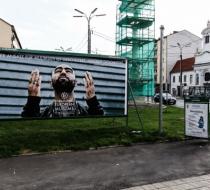Rebranding European Muslims Favorite
Public Movement is a Tel Aviv based ‘performative research body’. Through large-scale performances in the public realm they construct alternative arenas for the consideration of communal identities – national, religious and cultural – revitalising debate around the distribution of power. They have initiated projects at the New Museum, Performa 11, Van Abbemuseum, the Israeli Center for Digital Art and, most recently, at ‘Baltic Circle’, the International Theater Festival in Helsinki. In 2012 they began the project Re-Branding European Muslims to investigate conflict around Islam in Europe and the use of branding by nation states, such as the EU, in the management of multiculturalism. Public Movement gave three branding agencies – Demner, Merlicek & Bergmann; Love Tensta; and Metahaven – the brief to ‘rebrand’ European Muslims. Their proposals were presented at a gala at the Steirischer Herbst festival in Graz on 28 September 2012 and the audience were asked to vote for a campaign. Voting was done publicly with individuals required to stand in order to cast their vote, dramatising the traditional gala sequence prevalent in both the arts and politics. The campaign by Demner, Merlicek & Bergman (DMB) won the vote, and was shown on billboards throughout Graz in Autumn 2012. Additionally the project as a whole was included in a major national branding competition, and became the focus of controversy in the Austrian national press.
Public Movement’s gala suggested an alternative approach to the celebration of a historic anniversary – one that looked beyond the purely ritual purposes of these kinds of events into the constructive potential they carry – an anniversary that not only commemorates a moment in the past, but reactivates it within the present to recognise the repercussions it had, and continues to have, for identity formation. The different performative elements of the gala – politicians giving opening remarks, branding strategists pitching their campaigns, Muhammed Asad’s speech, Austrian belly-dancers, the Bosnian choir and even the gala itself – were juxtaposed to create overt and covert conflicts, and to transgress the typical appearances and settings of these kinds of performances.







